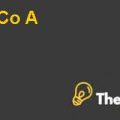Caterpillar Tunneling Canada Corporation Case Solution
Introduction
Caterpillar Tunneling Canada Corporation was established in 1972, under the name Lo vat Inc., which was later converted to Caterpillar Tunneling Canada Corporation, with its headquarters established in Toronto, Canada. The company employed a staff of 330 people, which included sales agents stationed across the world.
Which, in turn, enabled the company to expand its reach on a global scale and give its potential clients the accessibility to engage with the company through its sales agents. The company was a subsidiary of Caterpillar Inc., through which, they acquired Lo vat Inc. After implementing the plan to enter into the tunnel boring business.
Lo vat Inc. was later named Caterpillar Tunneling Canada Corporation. Moreover, Caterpillar Inc. was formed through the merger of Holst Manufacturing Company and C. L. Best Tractor in 1925,which, in turn, enabled them to be recognized as the world’s largest manufacturer of heavy equipment. Additionally, the company was already engaged in many other industries, which included mining, construction, forestry and agriculture.
They provided a range of diversified products to its prospective clients.More so, between the years 2005 to 2006, the company decided to transform its business through the implementation of SAP in its business model.This enabled the company to enhance its share in the market and gain a competitive edge over its competitors in the highly diverse and competitive market.
Analysis
After analyzing the case, it can be determined that, the company was in dire need of an effective IT infrastructure and ERP management system. This would ensure that the management could produce timely and accurate financial reports to help them evaluate the performance of the company, compared to the budgets allocated and with respect to other organizations operating in the same market.
On the other hand, it was assessed that the company was facing significant issues due to its outdated ERP system, regarding data inconsistency, poorly defined production, business processes and ineffective reporting. Furthermore, it was evaluated that, the company decided to implement SAP in its business model just like its parent company.
However, due to budget allocation problems, it was canceled and instead a Business Intelligence platform was implemented, locally to make effective decisions. Information technology department was not regarded as a strategic business unit in CT-CC, and it provided a supportive function in the company.
Their IT manager, Simon Swiss was responsible for the supervision of global information services of its parent company in Toronto,which also supported some Caterpillar facilities outside of Toronto. This could have compromised his ability to effectively manage CT CC’s IT services and its HIS integration with the parent company, leading to inefficient IT resource allocation and management.
This could also compromise the company’s ability to convert its raw data into actionable business insight, which could then be used to make effective business decisions to increase their share and profitability in the market through increased sales. Parent company’s HIS system had exposed CT CC’s IT department to vast IT resources, which could be used to adopt stranded operating procedure that has benefited their parent company since its implementation.
The HIS system also secured the inflow and outflow of data from CT-CC, attributed to its corporate firewall. But despite this, CT-CC would not be able to take advantages of these opportunities, if the IT manager was preoccupied in traveling to and managing other facilities. Therefore, the management needs to consider that, the IT manager has sufficient time available to perform his duties effectively.
Furthermore, Costco's ERP department was small and operated under the same roof of its IT department. It was evaluated that, the ERP department consisted of two ERP analysts responsible for managing the ERP database structure queries for its custom informational supervised the ERP department, due to the inability of its parent company to guide the future management of Costco's system.
Caterpillar Tunneling Canada Corporation Harvard Case Solution & Analysis
Furthermore, its ERP system was not integrated with the GUYS system of its parent company, as its IT counterpart. Therefore, it can be determined that the management of the company should consider the implementation of an upgraded ERP system (SAP), to mitigate the risk of ineffective allocation of data and using this data effectively to drive relevant information from them.
Similarly, the management should also consider establishing a separate ERP department, independent from its IT department. This would allow them to establish effective communications between the departments and allocate more resources in the form of ERP experts, to effectively manage the function of database allocation of the ERP system................
This is just a sample partial case solution. Please place the order on the website to order your own originally done case solution.













